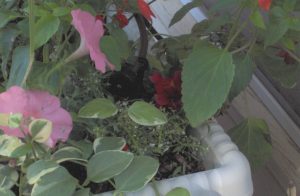
It sounds down-right derogatory, but I’m afraid it’s true… I’m a “control freak” in my garden! I have a very low tolerance for weeds, spent flowers are regularly removed and if a plant out-grows it’s designated space it gets pruned back or removed completely.
I’m also very controlling about the water use in my yard and you should be too — water is a precious commodity here in Colorado! A drip irrigation system is well suited to the Control Freak because it is efficient, effective and versatile.
Control Issue: Efficiency. By design, drip irrigation waters right at the soil surface. Therefore, no water is lost to over-spray onto the driveway or sidewalk. Water doesn’t blow away on a windy day nor evaporate on a sunny day. A drip irrigation system targets the water directly on the roots of the plants. Space between plants is not watered – this is especially helpful for controlling weeds between shrubs. Much less water is wasted in a drip irrigation system compared to sprayers.
Control Issue: Effectiveness. The soil along the Front Range is generally described as “heavy clay.” While the clay can be challenging to the gardener, it is also what makes this area livable at all — if our soil was sandy it would be like the Sahara Desert. A rarely mentioned benefit of our heavy clay soil is that it retains the water for days when it is well soaked. Drip irrigation provides a slow, steady precipitation rate. This allows our clay soil to absorb more of the water with less run-off. The slow, steady water provided by a drip irrigation system moves water throughout the entire root zone, down deep into the soil where it will be available to the plants for much longer than if you watered lightly with the hose. Your watering strategy for a shrub bed with drip irrigation should be to water for a long time (an hour or more).
Control Issue: Versatility. The interchangeable components of a drip irrigation system are adaptable to many different situations. Whether you are watering an ornamental grass border, a perennial flower bed or the container gardens on your deck, drip irrigation is very flexible. Pieces can be added and removed with ease and the watering rates can be varied so that one plant receives more or less water than its neighbor depending on individual plants’ needs. The versatility of drip irrigation is my favorite part! I am even guilty of changing pieces mid-season just to see if it will work better.
While drip irrigation is efficient, effective and versatile, I can’t recommend removing your entire lawn to lay down drip irrigation lines beneath the sod. Also, if your perennial flower bed is intensely planted, drip irrigation may not be right for you. Converting a shrub border or flower bed you’d like to convert to drip irrigation, may be much easier than you think. Of course, the convince of an automatic watering system (especially on your container gardens) can’t be beat.



